About this section
- Mobile Pollution Management Unit:
The unit is in charge of the control over mobile pollution sources and noise pollution sources, along with legal regulating and interpreting for non-ionizing radiation. Inspection or Appraisal of Pollutants; The Statistics Generation and Report and policy advocacy.
- Stationary Pollution Source Management Unit:
The unit manages the placements, changes and operation permits of stationary pollution sources, inspection and fee collection for the control over construction engineering and air pollution, inspections or appraisals for the pollutants emitted from public and private places, construction engineering and open burning fields, promoting collective burning for ritual paper money, generating statistical reports and policy advocacy.
- Air Quality Management Unit:
The unit is in charge of safekeeping and spending Air Pollution Funds of Tainan City Government, controlling air pollution, operating and managing air quality inspection stations, establishing and auditing the purifying areas, controlling indoor air quality and policy advocacy.
Achievements of this section
- Mobile Pollution Management Unit:
(1) Inspect diesel vehicles on roadside for 1,729 times, total 436 vehicles were inspected and 529 disqualified vehicle times were reported.
(2) Inspect total 6,165 vehicle times aiming at emission visual identification, highly polluted diesel vehicle reported by public and voluntary diesel vehicle inspection. Among them, total 1,533 vehicle times were noticed for inspection (emission visual identification, public report and re-examination for disqualified vehicles). 270 disqualified vehicle times were reported and 4,632 vehicle times were for voluntary inspection.
(3) Regarding the official vehicles and buses of the city, the number of the official vehicles needed to be inspected is 857, and the number of the buses needed to be inspected is 225; all of these vehicles have already been inspected, so the inspection rate is 100%.
(4) The proportion of scooter exhausted emission inspection has grown up from 2012. The average inspection ratio of 2017 is 81.0%, and the ratio is the highest over the years. The average inspection ratio of Tainan City is the champion in the country.

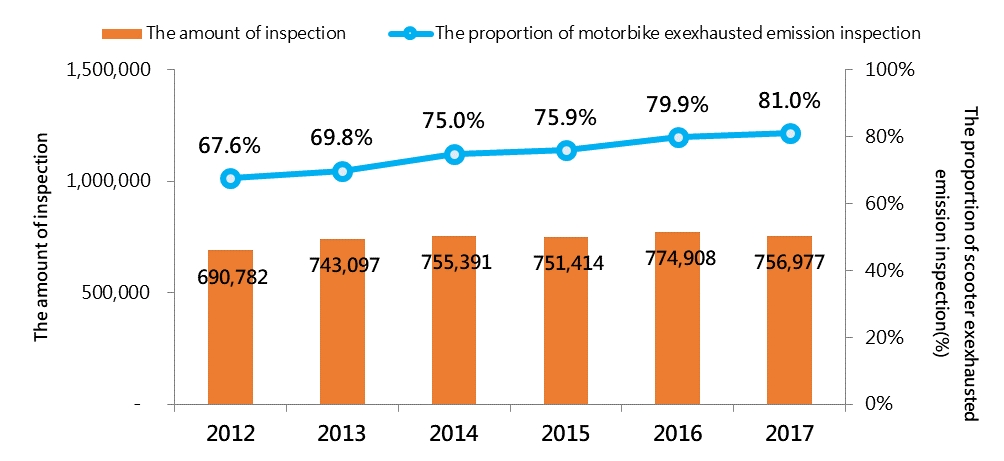
(5) There are 122,753 two-stroke scooters in 2017. The amount of two-stroke scooters which have been phased out from 2012 to 2017 is 317,713.

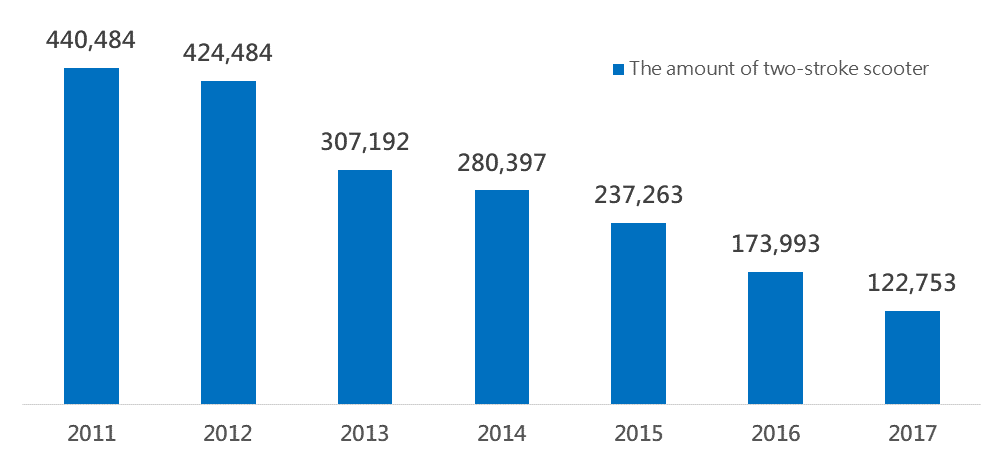
(6)Noise Control:
A. Performing the monitoring of non-fixed ambient sound volume and the traffic noise for 24 monitoring sites is total of 192 times.
B. Processing the tasks of noise detection of motor vehicles, and move back to the detector for 57 events with Police Department and Station of Motor Vehicles.
C. Execution to noise roadside inspection work for 1094 motor vehicles, Include the detection of 151 vehicles, results 51 vehicles was summonsed for failure detection.
- Stationary Pollution Source Management Unit:
1. Stationary source control:
(1) Accomplish collecting air pollution fee of stationary sources costs 17.840 million. Accomplish 324 times on-site audit of air pollution.
Air pollution fee supplementary payment rate first time to reach 100% within its jurisdiction. supplementary payment rate compared to 2017 on average pay 89% ,2016 on average pay 79% increase significantly. Reminders paying rate reach 100%.
(2)Stationary Sources Permits application documents examining and issuing totaled 438 permits. Operating permits on-site inspection has been performed on 750 operating permits. Among them, 79 operating permits did not meet the contents of permits.
(3) Using standard air pollutant testing method to inspect plumes of stationary sources.
We performed 9 plumes for PSN (SOx, NOx and particulate) testing, 3 plumes for dioxin testing, 3 plumes for heavy metal (Pd, Cd, Hg and As) testing, we also took 15 fuel samples from different plants to check if the sulfur content in the sample met the standard. Testing results for PSN of 3 public or private premises were not in compliance with standards.
(4) There were 214 factories fugitive particulate regulatory compliance inspection, and 12 factories were fined.
2. Construction sites Management and Inspection Project:
(1) During the period, there were 7,710 new construction sites to declare the Air Pollution Control Fees which totaled NT$152,756,441 Among them, 150 construction sites were reported because they overdue declared.
(2) The emission control of 11,703 sites at the construction site to check 20,800 times; the reduction rate of emissions on constructions upgrade from 63.90% to64.32% during 2016to 2017. Another the regulatory compliance of construction control increased from 77% to 90 % during the past year.

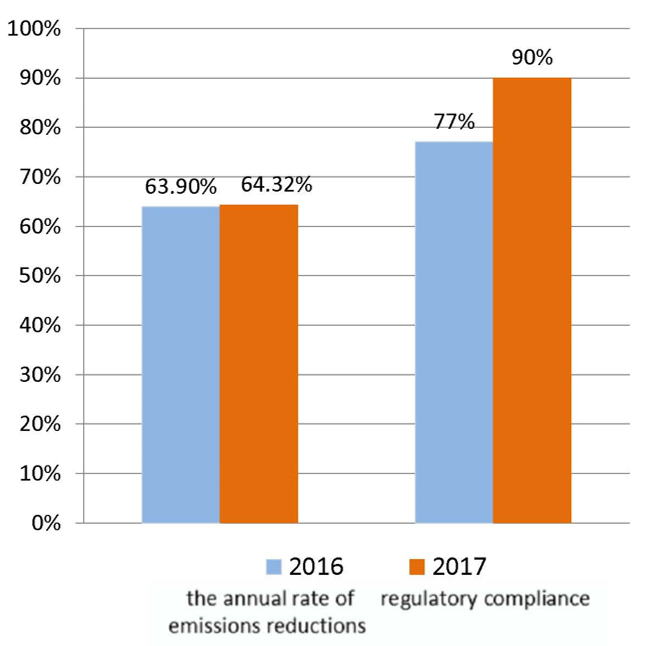
3. The reduction joss paper jobs:
There were 5,373 people take part in the “Joss Paper Reduction” by donating money, contributed NT 2.96million dollars; the amount of concentrated-burning joss paper was 1,515 tons, gathered from 1,314 units.
- Air Quality Management Uni:
1. Maintenance and improvement of air quality:
(1) In 2017, the improvement ratio of each major air pollutant compared to 10 years ago was listed as following: 26% for PM10, 40% for PM2.5,36% for SO2, 19% for NO2, 43% for NMHC, and 21% for O3(hr).

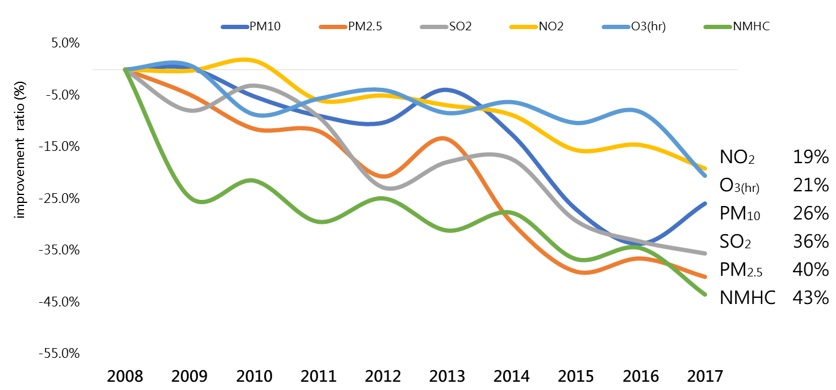
(2) Until the end in 2017, the percent of unhealthy level in air quality index (AQI>100) compared to 2016 was reduced by 1.9 % and had a declined tendency.

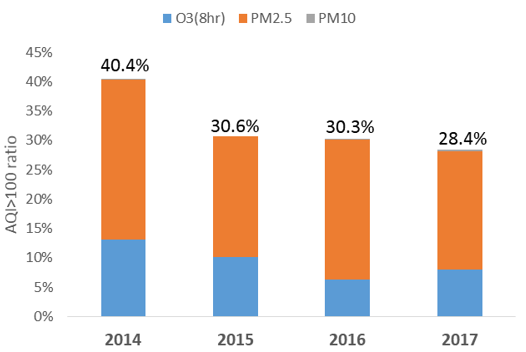
2. Street sweeping and washing:
(1) 67,261.1km of street length were swept and 74,557.2 tons of qualified discharge water were used.
(2)Integration of street sweeping and washing capacity by incorporating the cleaning teams of 37 districts, 9 industrial and science park service centers and 78private businesses; in total 359,531.0km of street length were swept and washed.
3. Indoor air quality improvement work:
(1) Patrol inspection conducted direct reading instrument-based inspection of 147 public sites within our city. (Including the first announcing public sites and the second announcing public sites in Tainan City)
(2) There were 101 executed sub-standard inspections in each environment.
(3) We held a cross-office horizontal negotiation conference with 9 municipal government units to discussing responsibilities and obligations of each office and items of work divisions.
Tainan Low-Carbon-City Project Office
A “Low-Carbon City” is one of the four development visions of Tainan, representative of an environmental commitment to future generations. We are steadfast in our effort to promote low-carbon policies. In 2011, Tainan became the only nationally-recognized model low-carbon city in southern Taiwan. In addition, we at the Tainan City Government translated climate mitigation ideas into specific measures, by launching “Perfect Ten: Low-Carbon Actions in Tainan.” Mayor William Lai designate 2012 as the “first low-carbon year” of Tainan, calling for the participation of every citizen to live sustainably. As a forerunner for climate cause of the country, Tainan promulgated the “Self-Government Rules for Making Tainan a Low Carbon City” on December 22nd, 2012, further testifying to the city’s resolve to specific climate mitigation actions.
Adaptation and Mitigation to Climate Change in Tainan City
"Resilience" is the key in successful, future-proof urban planning and urban development: in addition to racing against time to minimize climate-induced costs, governments must also consider environmental sensitivity and responsibility in their urban planning and development programs. "Mitigation" and "adaptation" are two overarching climate change response strategies adopted to combat global warming. The former aims at reducing the greatest culprit of climate change - greenhouse gas emissions; the latter addresses effective response strategies to battle the impacts of global warming. Both "mitigation" and "adaptation" measures have to be executed in tandem to take effect; they also require wide public support to minimize climate change-associated risks and threats. With that, both mitigation and adaptation solutions can ensure humanity a chance at sustainable survival in the face of global warming-triggered environmental and social changes.
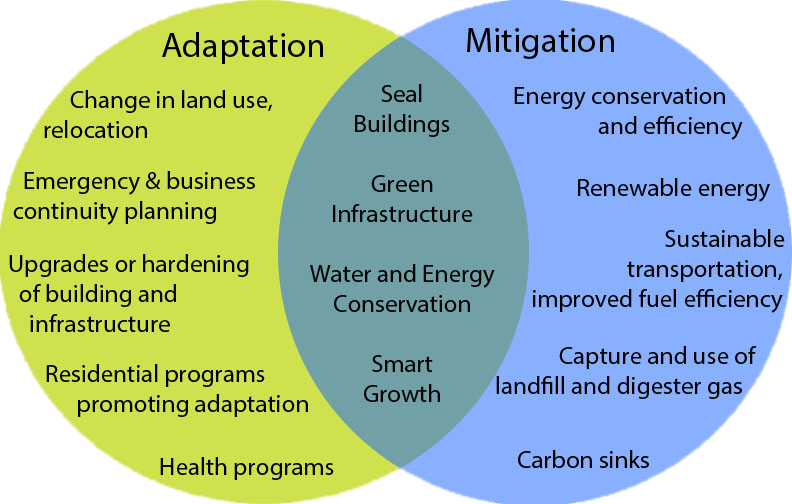

Vision & Strategies for Promoting Low-carbon City
In response to the implementation of the Act, nationwide GHG emission targets, and the enforcement of the Paris climate pact, the Tainan City Government also identified several reduction goals: for it’s the first-stage objective, GHG emissions should be 2% below the 2005 level by 2020, which equals 1.77million metric tons of carbon exhaust; for it’s the second-stage objective, GHG emissions should be 10% below the 2005 level by 2025, which equals 3.34million metric tons of carbon exhaust; for the city's the third-stage target, GHG emissions should be 20% below the 2005 level by 2030, equaling 5.3 million metric tons of carbon exhaust. Finally, for the city's long-term target, GHG emissions should be 50% below the 2005 level by 2050, equaling 11.14 million metric tons of carbon exhaust.
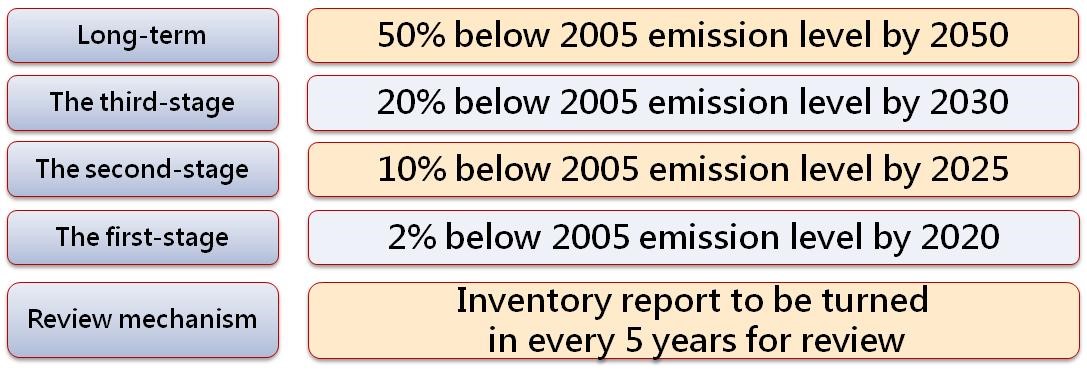
Future-building a sustainable and resilient city
Our city, Tainan, will make green policies as our foundation, combining them with innovative regulations, and launching a low-carbon city promotion commission to develop clear reductive targets, strategic directions, incentives, counsels and principles. Moreover, we would like to engage every community and industry in the city's bid to perpetuate a low-carbon lifestyle and culture, and promote a green lifestyle collectively as an urban community.